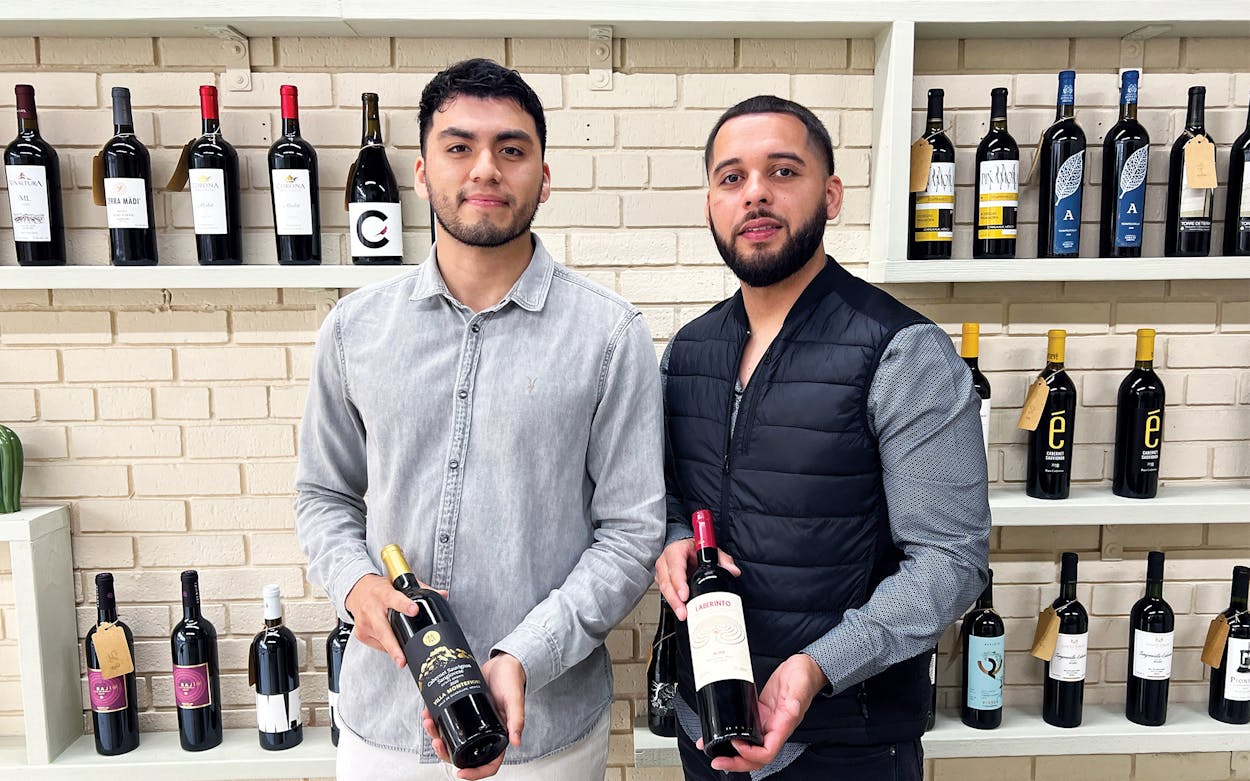Arturo Flores and Eduardo Mendoza can’t help but smile when they talk about Mexican wine. Standing inside their five-month-old, 330–square-foot wine shop, Vinito, their effusiveness lights up their faces. With their neat haircuts and trim button-downs, they resemble the proprietors of a big city storefront rather than one in the rapidly gentrifying neighborhood of Oak Cliff, just south of downtown Dallas.
Located near the corner of Polk and Jefferson, Vinito sits along the edge of the historic Latino commercial district. It’s across from a torta joint and around the corner from a taqueria. Of course one of the first Mexican wine shops in Texas fits right in.
During our conversation, a woman and her boyfriend enter the shop, taking stock of the space, with its white-painted brick walls and floating white shelves featuring not only wines from the Valle de Guadalupe, “the Napa of Mexico,” but also from Coahuila, Guanajuato, Zacatecas, and more. Mendoza, age thirty, excuses himself to attend to the potential customers. He returns a few minutes later as the couple walks out, a bottle of red wine in hand.
“She was surprised there was a Mexican wine shop,” Mendoza says. “So I showed her around, asked her where she was from. She said Queretaro. She was excited to see we had wine from her home state, and she bought it.” It meant as much to Flores and Mendoza that a fellow Mexican American popped in. Mexican immigrants and their children are always looking for a piece of home, be it a regional dish or, now, wine.
Fine-dining restaurants in the state, such as the pricey Don Artemio in Fort Worth, stock a growing list of Mexican wines, but Vinito is a more approachable entry point for locals, with some bottles being as low as $23. Flores and Mendoza share that their customer base includes both Latinos and Anglos. “We’re blessed,” Mendoza adds.
The friends met while working at Meso Maya, an upscale Mexican restaurant in what used to be Dallas’s Little Mexico but is now the Uptown neighborhood. Flores, who is 27, was working there while studying to become a mechanical engineer. Mendoza was continuing his career in hospitality and retail. They hit it off over an amazement that the restaurant served Mexican wine. At the time, Mendoza already had some practical experience with Mexican wine. While visiting his in-laws in San Luis Potosí, he took time to travel to the nearby Pozo de Luna vineyard. But Flores’s sole knowledge at the time was the bottles at Meso Maya. It was enough to strike his curiosity to the point of obsession.
When the pandemic hit, Flores studied for the certified sommelier examination from the Court of Master Sommeliers. He achieved a level-one certification, but notes that at the time the exam had only one slide on Mexican wine, and it shared space with Israeli wine. In one of his textbooks, there were just a few pages on Mexican wine, even though the first winery in the Americas, Casa Madero, was established in what is now the Mexican border state of Coahuila, in 1597. Eventually Flores and Mendoza decided to use their downtime to plan to open Vinito. They began building relationships with winemakers, importers, and distributors. They looked into the availability of Mexican wines and were astonished at how little there was on the market, but they remained undeterred. They opened Vinito in October 2023, with 130 labels for sale.
The first day was a two-hour tasting for friends and family, but it was enough to start word of mouth going. It struck a chord with the community during the holiday season as people shopped for gifts. Someone might come in and say their dad is from Durango and their mom is from Chihuahua, and they want to know what the shop has. “They take it over to their house for Christmas and they’ll return,” Flores says. “The customers would say, ‘[My mother] couldn’t believe it was from Chihuahua, and I’m here again.’ ”
While studying for his level-one certification and planning the business, Flores says, he didn’t just fall in love with wine: “I fell in love with my culture all over again.” He goes on to speak of terroir: the concept that factors such as soil type and climate give a specific wine its own flavor, body, and aroma. Wine is of a time and place. The same goes for Mexican wine. “Some of the red wines have notes of hibiscus,” Flores says. “Some have a little hint of chile de árbol. Some wines are spicy like the cabs.” There are also natural wines and even native Mexican grapes, such as Rosa del Peru.
Centuries of immigration also influenced the wine scene in Mexico. People from France, Germany, Italy, Spain, and the Middle East brought their grapes and expertise to create a market that still has huge potential. But this isn’t just a business for Flores and Mendoza, who also maintain full-time day jobs—Flores works as an engineer at a design firm and Mendoza works in health insurance—this is about culture. “We’re more than just coming in and working out of the store,” Flores says. “We’re ambassadors for Mexico.”
Mexican Wine Recommendations From Arturo Flores, Co-owner of Vinito
Dominio de las Abejas Nebbiolo 2021: Pair this springy, jammy natural wine with crispy yet tender carnitas.
Cava Quintanilla Chardonnay 2021: Take this oaky bottle to your next summer cookout to sip alongside pollo al carbon and mole verde.
Barrigon, Tempranito, Caberne & Merlo 2021: Flores prefers to drink this wine with “my mom’s guajillo-braised short-rib guiso,” he says, which elevates the subtle blend of his favorite grapes.








